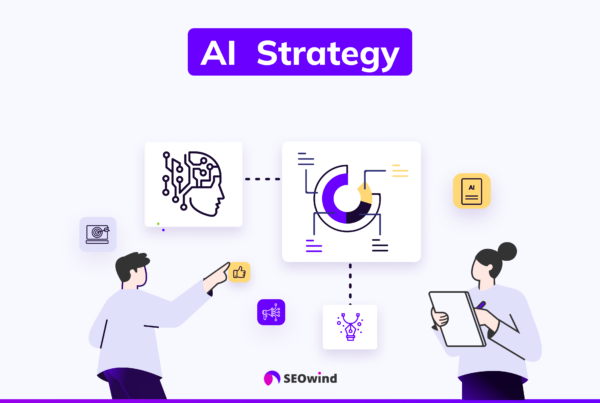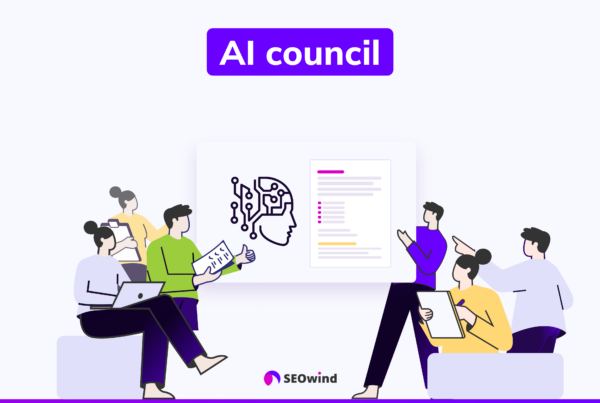Content is king. We all know that. But as a marketer or business owner, you’re not crafting compelling content purely for fun. Your eye is on measurable outcomes and tangible returns. So, how do you prove the value of your content marketing? It all circles back to three words: Return on Investment (ROI). In this article, we will explore the essential aspects of content marketing ROI, covering everything from metrics and calculation methods to established benchmarks and improvement strategies.
What is the ROI of Content Marketing?
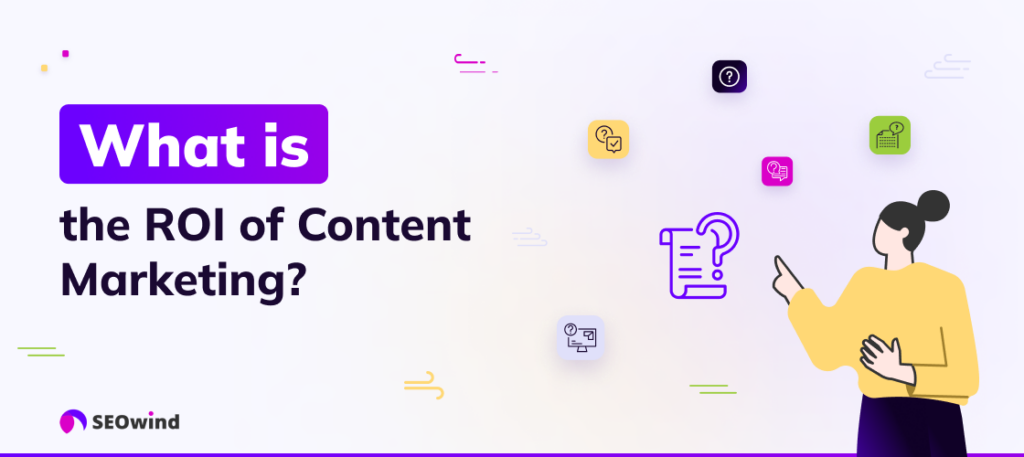
Brief Explanation of Content Marketing ROI
To kick off this journey in earnest, let’s explore what we mean by content marketing ROI. At its core, content marketing ROI is a ratio that compares the net profit made through your content marketing efforts to the total cost invested in those initiatives. Essentially, it quantifies how much value you get from your investment. If your ROI is high, then your content strategy has hit a sweet spot. If not, it might be time for some tweaks and improvements.
The Necessity of Measuring ROI for Business Growth
You might wonder why there’s so much fuss about measuring ROI. Couldn’t one simply gauge success via likes or shares? Well, while these indicators give some insights into engagement levels, they don’t necessarily translate into sales. So, our focus should be on content marketing ROI because, ultimately, every penny invested should drive growth.
Tracking your investment in conversions and sales speaks directly to revenue, which in turn fuels business expansion and innovation. Furthermore, measuring ROI helps pinpoint which facets of your strategy work best and which need refining. This allows you to target efforts that bring home robust results precisely. It’s like X-ray vision giving us insights on each dollar spent while plotting our course ahead. Actionable insights gained today can substantially impact revenue over time. Think of ROI as the compass guiding your journey to successful content marketing—it’s that crucial.
Understanding Metrics to Measure Content Marketing ROI
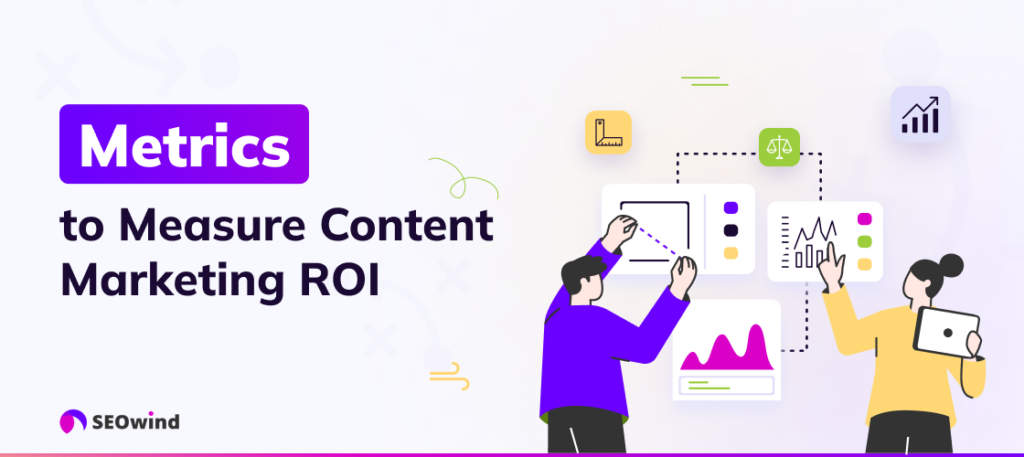
Content marketing ROI is a touchstone metric that tells you whether your content strategy works. However, it can be challenging to calculate. Before we get into how to do that, let’s discuss the various metrics used to assess content marketing results.
In-Depth Analysis of Consumption Metrics
Consumption metrics are fundamental to understanding how audiences interact with your content and play a vital part in calculating marketing ROI metrics. These measure basic indicators like page views, downloads, and time spent on each piece of content.
According to Forbes, “Marketers who track metrics are 3x times more likely to report success.” With these measurements, we can establish an engagement baseline for future comparisons and analysis.
For instance, blog consumption can be tracked by checking changes in organic traffic or observing general access trends like pageviews or unique visitors. Similarly, video performance can be monitored via view counts and watch-time durations.
The Role of Sales in Determining ROI
The translation from audience interaction to actual financial profit is another cornerstone when discussing the measurement of marketing ROI. Monitoring overall revenue or specific sales events generated as a direct result of content campaigns can paint a clearer picture of effectiveness.
Adopting a comprehensive ROI model should take lead nurturing strategies into account, with calls to action intended to drive tangible profits embedded in every piece of content.
Evaluating Lead Quality and Conversion Rates
It’s also valuable to assess the quality of leads generated and their conversion rates. Doing so strengthens our understanding of pre-sales effectiveness.
Higher quality leads naturally bring improved conversion rates. Therefore, tracking who engages with your brand and how often they go on to convert helps refine targeting techniques and further optimize cost-effectiveness by investing smartly where the best responses have been registered.
While there’s no universally applicable benchmark for excellent ratios due to differences between industries and target audience behavioral trends, Forrester Research indicates that “Top performers convert 1.54% of leads to marketing qualified leads (MQLs)”.
Impact of Social Media Metrics on Overall ROI
In the age of digital communication, social media engagement levels make a huge impact when monitoring marketing success. Shares, likes, comments, or followers can reflect the public sentiment of your brand. Although they may initially serve vanity calculations, they indicate potential viral outreach effects, positively influencing market penetration rates and enhancing overall business performance.
The Influence of SEO Performance on Content Marketing ROI
Finally, we can use Search Engine Optimization (SEO) indicators to determine ROI. Improved website rankings increase visibility and organic traffic – both quantity and quality. In measurable terms, this means more clicks, higher click-through rates (CTR), and better session durations with lower bounce rates.
A well-designed keyword strategy’s main components complement portable content and contribute additional value for businesses aiming to reach larger audiences at lower costs, optimizing returns.
Overall, studying different metrics enhances your knowledge about processes involved in delivering successful content marketing campaigns while highlighting areas requiring adjustments for best results.
Calculating Your Content Marketing ROI: The Comprehensive Guide
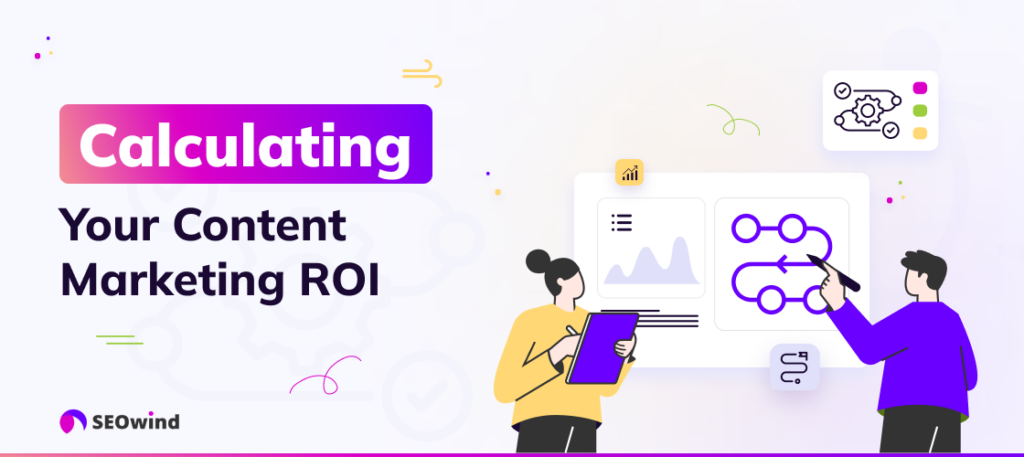
In these sections, I’ll walk you through calculating your content marketing ROI, followed by an easy-to-follow calculation process with tangible examples.
The Classic Content Marketing ROI Formula Explained
The classic ROI formula is a simple yet effective way to calculate the effectiveness of your marketing strategy. It summarizes the impact of your investment and compares it to the associated costs.
The mathematical representation is as follows:
ROI = (Net Profit / Cost of Investment) * 100%
This quantifiable percentage offers insights into how profitable your content marketing strategy is relative to its cost. Mastering this fundamental equation can confidently steer any marketer or business leader to make data-informed decisions.
A Step-by-Step Calculation Process with Examples
So, how do we get started? Here’s a straightforward step-by-step process that will aid the calculation of your ROI without breaking a sweat:
- Identify your Cost of Investment: This includes all amounts spent developing and distributing content, such as writer fees, designer charges, audio and visual production expenses (if any), promotion costs, and overheads related to hardware or software used, among others.
- Quantify Net Profit: Calculate this by subtracting the total amount invested from the sales revenue directly traceable to your content strategy.
- Use the two amounts obtained above to compute your marketing ROI.
Let me illustrate using an example:
Imagine you’ve invested $10,000 in content creation and distribution over one quarter. Thanks to this effort, you’ve made $30,000 in direct sales throughout that period.
Here’s how we’d calculate our ROI:
- Net profit: $30,000 – $10,000 = $20,000
- ROI: ($20,000 / $10,000) * 100% = 200%
This means that for every dollar spent on content marketing, you earned $2 in direct sales within the quarter, rendering your strategy pretty successful.
A cursory glance at these figures should warm any marketer’s heart! But bear in mind that these are hypothetical numbers that are only meant to illustrate how the calculation works. Actual metrics can vary based on variables such as industry sector, target audience, and chosen content types.
Establishing Benchmarks: What is an Excellent ROI?
When determining the success of your content marketing efforts, you need to know what a good ROI for marketing looks like. Identifying an appropriate target can be daunting at first, but let’s unravel this query.
What Is a Good ROI for Marketing?
The truth is that there isn’t one size or standard number that fits all businesses when defining what constitutes a “good” ROI for marketing. The value can differ wildly depending on various factors such as industry type, the maturity of your business, and its objectives.
For instance, imagine you’ve launched an online platform selling handmade leather goods. Initially, observing even incremental sales increases would be a worthy ROI target. Conversely, if you’re assessing from the perspective of an e-commerce titan like Amazon, these small increments may carry less weight.
For practicality’s sake and to set a preliminary benchmark, consider following finance guru Warren Buffet’s advice: set out to have at least $1 return for every $.50 spent for an exemplary 100% return. However, achieving this constantly is highly improbable.
Industry Averages for B2B and B2C Content Marketing ROI
We can review industry data to provide some contextual insight into average on-field figures. According to Demand Metric’s research:
- On average, organizations allocate around 26% of their annual budget to content marketing. Businesses that have less than ten employees dedicate only about 15%. Meanwhile, larger corporations with more than a thousand personnel earmark closer to 24%.
- Almost half of B2B companies rate their content market ROI positively. In contrast, indirect benefits like enhanced brand reputation and lead quality are rated highly by around 20%.
- Per the CMO Survey, B2C services reported an average marketing ROI of 14.24%, and B2C product earning was 15.62%. However, it’s worth noting that these reflect median values. Your business may yield higher or lower returns based on the aforementioned variables.
It’s crucial to track industry trends and standards, but bear in mind each business has its unique dynamics. While averages provide an orientation gauge, they shouldn’t restrict your expectations or strategy flexibility!
Considering a variety of success descriptors apart from strict tangible figures will allow you to assess the rounded value content marketing brings to your overall business growth.
Significant Content Marketing ROI Statistics You Can’t Ignore
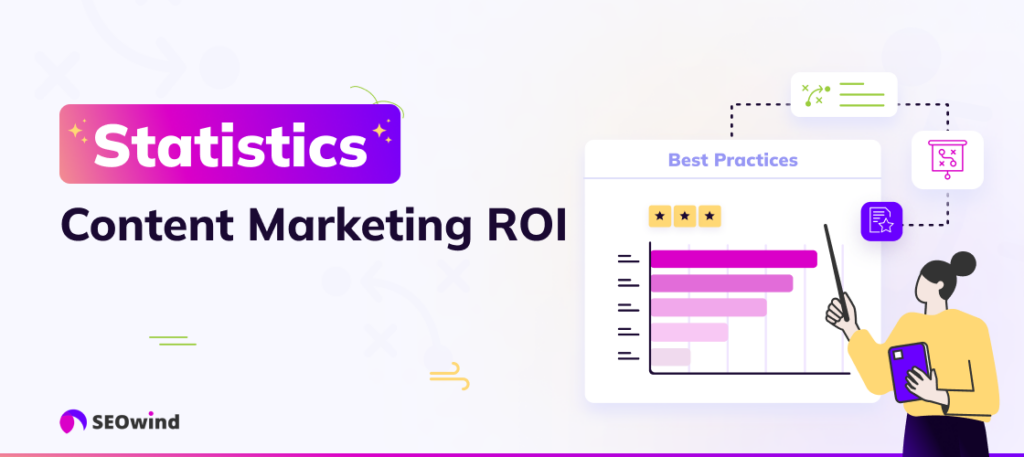
Now, let’s examine ROI stats, shall we? We can start by reviewing some thought-provoking statistics that clearly portray content marketing’s direct influence and current state. These numbers have reverberating implications for businesses worldwide.
Current State and Direct Impact Data of Content Marketing
- Patience is key: Let’s begin with an astonishing statement from renowned content marketing expert Joe Pulizzi, reported by Ann Gynn at CMIContent: it takes 12 to 18 months to build an audience through content marketing. This stresses the significance of patience and perseverance in achieving meaningful results from your content marketing strategies (Source: CMI).
Unfazed by these demanding timelines, companies continue to embrace this approach due to the substantial return on investment that content marketing promises.
And why is this the case? Because studies have shown that:
- Conversion chart: Content marketing generates over three times as many leads per dollar spent compared to traditional marketing techniques.
- Cost Efficiency: It costs 62% less than traditional marketing while generating approximately three times the number of leads (Source: CMI).
- Nurturing Potentiality: Nurtured leads make 47% larger purchases than non-nurtured leads.
- Influence Benders: Influencer-generated content provides an ROI 11 times higher than traditional digital marketing campaigns.
These pertinent ROI statistics reflect the dividends that content marketing can offer businesses when effectively executed. Analyzing and using these figures to direct your strategies can catalyze stellar growth for your brand while enabling a promising financial future. These figures emphasize the influence and viability of content marketing in today’s digital landscape and its potential return on investment.
Looking at these numbers, one could daringly envision the potential long-term profitability and sustainability if such tactics were employed substantially within their own business models! Are you ready to pull back the curtain on more content marketing ROI secrets?
Barriers to Calculating Accurate ROI and How to Overcome Them
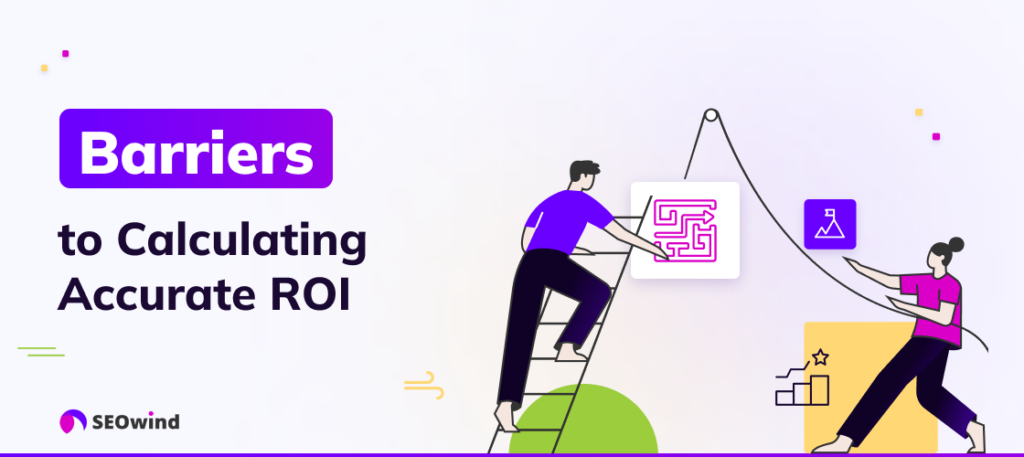
Inefficiencies in calculating content marketing ROI can often be a roadblock, but these hurdles are surmountable with the proper perspective and strategies. Let’s review some common barriers and explore possible solutions.
Intricacies of Tracking Multiple Channels
Keeping tabs on multiple platforms, such as social media networks, blogs, and email marketing systems, can be quite challenging. It becomes inherently tricky when trying to get an accurate picture of your ROI since customer interactions happen across various channels.
The solution is advanced analytics tools that allow multi-channel tracking and provide a unified view of customer interaction data. This approach reduces the complexity involved in manually monitoring different platforms.
Difficulty Determining Quality Leads
An influx of leads doesn’t necessarily secure returns; quality makes all the difference. Distinguishing high-quality leads from others can pose another barrier when estimating ROI accurately, given the elusive nature of “quality.”
You can tackle this by defining what constitutes a quality lead for your business at the outset. One size does not fit all! Establish criteria based on factors like purchasing power or engagement levels, with your content clearly outlining what signifies quality for you.
Integrating Offline Marketing Efforts
Not all promotional activities take place online. Offline events also form part of your overall marketing strategy, making it hard to integrate such efforts when calculating ROI.
Despite its challenges, it’s beneficial to incorporate offline initiatives into your calculation process through promo codes exclusive to offline events or custom URLs leading to a landing page designed specifically for an event audience.
Non-Measurable Outcomes
Some aspects of content marketing, like brand reputation enhancement or trust-building, are incredibly valuable but challenging to measure tangibly in terms of dollar value.
To overcome this hurdle, “Sentiment Analysis” is an effective tool. It helps quantify the often qualitative customer sentiment data by scoring phrases or words based on their perceived positivity or negativity.
Overcoming these obstacles allows for more accurate ROI calculations and a more accurate reflection of your content marketing’s value. It’s not an easy task, but with resilience and strategic problem-solving, it can transform from a barrier into an enabler!
Trends Affecting Content Marketing ROI Today
As we navigate the content marketing landscape, staying alert to developing trends is crucial. These trends ultimately impact your ROI. Let’s look at a few recurring themes and new developments that content strategists should consider integrating into their approach.
The Rising Importance of Video and Interactive Media
Sometimes, no matter how much I love them, words aren’t enough. Video and interactive media have an essential role in today’s digitally-driven world. Let me explain why.
Characterized by dynamic visuals and immersive storytelling, video formats captivate audiences like no other medium. Recent studies have found that viewers retain 95% of a message they receive from a video compared to just 10% when reading it in text form [Source: insivia].
Meanwhile, interactive media takes audience engagement one step further. It acts as a visual representation of your subject and allows users to actively engage with content such as quizzes, polls, or infographics.
In addition, these types of content:
- Increase the time spent on your platform, thereby boosting user engagement.
- Build an emotional connection between brands and their audiences, aiding customer acquisition and retention.
- Provide valuable data about customer interactions, which feed directly into ROI calculations.
Leveraging these mediums draws attention to your content and enables a deeper audience connection that leads to tangible business outcomes.
Don’t get me wrong, written content still has an integral place in contemporary marketing strategies! However, supplementing it with interactive elements or engaging videos packs the extra punch needed to bolster your ROI.
Proven Strategies for Enhancing Your Content Marketing Efforts and ROI
As you continue to explore strategic marketing ROI, the correlation between investment and return starts to surface. But how can you maximize your content marketing efforts to ensure a high ROI? Are there proven strategies that can help enhance this? Fortunately, my answer is a resounding yes! Let’s explore these high-impact strategies.
Creating High-Quality, Engaging, and Relevant Content
Not just any content will do. It must meet three key qualifiers: high quality, engaging, and relevant. By producing material that fulfills these expectations, you can increase your conversion rate, which ultimately boosts ROI. Diving headlong into data analysis unveils your target audience’s preferences. This provides the foundation for creating the specific material they crave.
Update Your Content Regularly
Content updates keep information current, which is crucial for maintaining audience engagement. Google algorithms favor new content and propel them higher up the rankings. This is another excellent reason to regularly refresh your blog or site while maintaining quality.
Personalization Techniques for Different Stages of the Customer Journey
Arguably, nothing improves the customer experience more than personalized service delivery. It adds an emotional tone to your brand and strengthens bonds with customers who feel valued and understood.
From the awareness to loyalty stages, personalizing emails has proved invaluable in increasing conversion rates.
Repurpose Your Content
Did you know that repurposing well-performing existing content across multiple platforms increases its life expectancy? Doing so maximizes reach as every platform hosts diverse user demographics awaiting your posts.
Optimize Your Content
The importance of adapting website articles or blog posts for mobile users cannot be overstated, considering approximately 50% of global web traffic originates from mobile devices. Include SEO tactics like using appropriate keywords, meta descriptions, headers, and more to increase visibility and boost ROI.
Create Internal and External Links
Search engines rank linked content highly based on their relevance. Linking internal articles supports easy navigation while providing additional helpful information. Meanwhile, external links indicate authority, particularly if they’re from reputable sites. This leads to increased trust.
Level up Your Video Content and Dedicated Visuals
Visual-based content is a powerhouse for audience engagement because it simplifies comprehension. The ascension of video marketing reinforces this strategy, with usage growth projected in the foreseeable future.
Promote Your Content Through Social Media
Social media shapes opinions, making it an invaluable platform. In addition to sharing articles or blog posts via personal accounts, leveraging paid social ads, including sponsored posts and advertisements, dramatically expands your reach, which in turn has a significant positive impact on your ROI.
Exchange Content with Reputable Sources
Guest posting or writing informative articles for esteemed publications introduces your business to new audiences. This can bring about new collaborations or partnerships, further enhancing your brand’s authority.
Collaborate with Other Content Creators
Team up with other creators within similar niches through webinars, podcasts, or blogs. In this way, you provide each others’ audiences with greater value while simultaneously attracting potential customers!
Strategic tactics are pivotal for maximizing ROI in content marketing efforts. By applying these strategies and persistently analyzing outcomes to ensure continuous improvement as needed, your brand will soon be ahead of the curve.
The Secret Benefits: How High-Ranking Organic Traffic Contributes to Long-term ROI
An Introduction to Organic Traffic and Its Role in ROI
It’s not always financial gains or conversion rates that reflect a high ROI from content marketing. Organic traffic is another critical way to obtain a substantial return. In this section, I will unmask the secret benefits tied to high-ranking organic traffic.
Conversion as an Outcome of Quality Rather Than Quantity
Let’s start by debunking the common perception that more traffic guarantees higher conversion. While we all aspire for enhanced visibility and a deluge of site visitors, what truly matters is whether they become loyal consumers or begin to echo your brand message. Let me put it this way: larger traffic numbers are helpful when those visitors are genuinely interested in what you have to offer.
Engaging Within Your Circle
How does targeted organic traffic feed into our original discussion about improving your content marketing ROI? Well, when you attract people who are already fascinated by your industry niche or product category, your level of engagement will rise quickly because you’re honing in on quality leads. This increases subscription rates, downloads of gated guides or whitepapers, form fillings, and trial sign-ups, which are all direct indicators suggesting that your content resonates with readers and indirectly contributes to revenue generation.
Building Authentic Brand Advocacy
One underrated aspect of audience engagement is the power of word-of-mouth recommendations generated by satisfied customers. They can become the catalysts for further growth through client referrals and social media advocacy, which contributes to the ranking of your website in search engine results.
So remember:
- Organic traffic signifies relevancy and user interest
- Quality trumps quantity when driving conversions
- Genuine engagement enhances brand recall
- Every new brand devotee amplifies your reach and authority
These secret benefits have a positive impact on long-term ROI. As content marketers, we need to acknowledge the importance of organic traffic.
Ultimately, measuring content marketing strategies requires a multi-dimensional approach. While money metrics like sales and lead conversion are vital, non-monetary factors like brand awareness, audience loyalty, and high-ranking organic traffic also influence overall ROI considerably. After all, digital marketing is as much an art as it is science!
Measure Beyond the Numbers: Customer Loyalty, Brand Reputation, and Authority
It’s crucial to look beyond numerical data when examining content marketing ROI. Other valuable aspects deserve attention, such as customer loyalty, brand reputation, and authority, each of which can fuel long-term company growth.
The Role of Customer Loyalty in Your Content Marketing
Developing a loyal customer base is one of the primary goals of any successful business. These are individuals who believe in your brand, consistently choose your products or services over competitors, and often act as ambassadors by referring others to your company.
A loyal follower can be worth up to 10 times their initial purchase, according to research by Bain & Company. But how does this relate to content marketing? If your content continuously offers value, solves issues, or educates consumers effectively, it can build a sense of trust and loyalty among readers, leading them back to you time and again. This reciprocal relationship leads to increased sales and creates advocates for your brand.
Evaluating Brand Reputation through Content Quality
Establishing a strong brand reputation goes hand in hand with high-quality content. More than just filling white space on a webpage, well-crafted content reflects your business’ reliability and professionalism.
When audiences consistently see valuable information shared through various platforms, it gives the impression of industry expertise, enhancing your brand’s image. So, even though analyzing brand reputation doesn’t produce immediate tangible figures like analytics, its impacts will eventually shape buying behaviors and influence conversions significantly.
Leveraging Authority Through Thought Leadership
There’s no magic wand that will instantly elevate industry leader status overnight. Thought leadership is a diligent process where businesses establish their brands as authoritative entities in their niches.
Thought leaders aren’t born overnight. They’re created through consistent, intelligent content that incites debate or guides market trends. Serving as a trusted source positions your business as an industry go-to, attracting higher-quality backlinks and commanding domain authority. This improves SERP rankings and boosts ROI in the long term by amplifying exposure and credibility.
When considering content marketing ROI, don’t confine your measurements to quantifiable data. Gauging customer loyalty, scrutinizing your brand’s reputation through its content quality, and leveraging authority via thought leadership are all valuable elements of measuring – albeit subtly – your return on investments in holistic terms.
Using Analytics Tools to Track Success: An Overview of the Best Platforms

Every marketer must be familiar with analytics tools. These software solutions empower you to accurately track your ROI and continuously optimize your strategies. But what are the best platforms that provide this kind of support? Let me introduce some of the outstanding options that have been a game-changer for many marketers around the world.
Google Analytics
A conversation about analytics tools is never complete without mentioning Google Analytics. Admired by beginners and experts alike, it provides exhaustive insights into web traffic sources, user behavior, and conversion rates. In addition, its integration capacity with SEO tools like SEMRush makes it invaluable for measuring content effectiveness.
HubSpot
Another impressive tool for tracking content marketing performance is HubSpot. Known for its all-in-one inbound marketing features, HubSpot also offers precise data related to page views, click-through rates (CTR), interactions per visit, audience demographics, and virtually everything you need to calculate ROI.
Moz Pro
Many brands have turned their fortune around just by using Moz Pro to analyze their SEO efforts. This platform offers excellent keyword research features, competitor tracing options, and comprehensive reports on site crawlability and ranking enhancements, which are core areas contributing significantly to quality organic traffic.
Hootsuite
To measure how well your social media endeavors are aiding your overall ROI calculations, consider investing in Hootsuite. With real-time updates about follower growth rate or engagement per post available at your fingertips, gauging success has never been easier!
Remember that these platforms are just suggestions in a sea of possibilities. Every business has unique needs. What works best might differ for each company. Don’t hesitate to experiment until you find the tool that responds most effectively to your specific requirements.
You’re already one step ahead by incorporating these analytics platforms into your strategy and understanding how they fit into calculating ROI. Once carefully picked as per your business demands, these tried and tested tools can considerably boost your results, providing invaluable assistance on the road to content marketing success.
Advanced Tactics for Incremental Improvements in ROI
Have you ever climbed a mountain? If you have, you’ll know that scaling up doesn’t happen in giant leaps. It’s all about constant and consistent steps. You wouldn’t try to reach the peak in one go, would you? The same principle applies to improving your content marketing ROI. There’s no magic bullet. However, by implementing specific advanced tactics, some subtle tweaks here and there can make a world of difference.
Build on What Works
First, double down on what’s already working (per Peter Drucker’s advice, “Do more of what works”). Content that has previously performed well is a foundation you can lean on. Don’t abandon it outright. Instead, try to amplify these successes. For instance, expand it into an e-book or video series if a blog post garnered high traffic.
A/B Test Everything
Second, invest time in continuous A/B testing. Not just with subject lines or headlines but quite literally every aspect, including CTAs, form designs, page layouts, etc. It may seem trivial initially, but slight variations can improve your conversion rate.
Leverage Automation
Third, consider using automation tools as they are especially beneficial for repetitive tasks like sending emails or posting social media updates at specific times. Additionally, many offer integrated analytics features providing insights that could help optimize your efforts further.
Use Retargeting Techniques
Last is retargeting techniques, which target users who’ve interacted with your brand before through ads or other promotional methods. Remember their name and face when they’re revisiting your website. This doubles the potential engagements, enabling the optimal use of existing traffic.
That being said, remember Rome wasn’t built in a day. In the same vein, your ROI won’t climb drastically overnight! However, persistent application of these advanced tactics could eventually lead to a successful content marketing journey. The key is understanding that taking small, steady steps can result in a noteworthy improvement. After all, every tweak and enhancement counts!
Concluding Insights on Maximizing Content Marketing Investments
As we take a step back to reflect on the central theme of this piece, it is evident that navigating the complex discipline of content marketing requires more than cursory knowledge. Delving deeper into the ecosystem and leveraging the proper strategies will ultimately bolster your ROI.
Firstly, an essential aspect I cannot stress enough is understanding what ROI means for you. No two businesses are identical, with contrasting metrics driving unique narratives. Whether you boost website traffic, improve lead quality, or expand social media engagement, ensure the metrics align with your organizational goals.
Secondly, don’t miss out on the unseen benefits of comprehensive content marketing strategies. Take into account various metrics that contribute to your success.
Thirdly, adopting agile, adaptive strategies can assist your business in maintaining its edge as trends shift. Stay abreast of the latest developments, such as utilizing engaging video content or interactive media. These have proven invaluable in boosting audience engagement rates.
Finally, confidence shouldn’t lead to complacency. Continuous improvements are critical to this game. Don’t overlook growth opportunities, and keep fine-tuning strategies based on data-driven insights. Capitalize on advanced tactics that aim for an incremental boost in returns.
It’s a marathon rather than a sprint. Optimize incrementally and consistently for improved pay-off from your content marketing investments. Every small step taken counts towards achieving the goal of generating a high return on your investment.
What type of content has the highest ROI?

Our quest for maximizing content marketing ROI rightly leads us to this critical question: “What type of content brings the highest ROI?”
Let’s look into this!
Blog Posts
According to a study by Demand Metric, blog posts deliver excellent returns. Businesses that regularly update their blogs with high-quality articles observe a 13x increase in ROI year-over-year. Why is that? Blog posts offer value and information to the readers, establishing your brand as an authority and trusted resource. The SEO benefits of blogging further enhance its potential for high returns.
Videos
There is no denying that video content has taken the digital marketing world by storm! A report from Renderforest suggests that 78% of users get more website traffic after using videos. Thanks to platforms like YouTube and Vimeo, as well as social media integration, creating and sharing engaging videos has become more straightforward.
Case Studies
The Content Marketing Institute illustrates that case studies are one of the top three most effective B2B content marketing tactics. Nothing inspires trust better than seeing proof of success.
E-books or Whitepapers
Data from Statista shows eBooks were a successful method for lead generation for approximately 51% of marketers worldwide in 2018. These comprehensive guides can showcase your knowledge about an industry topic or solve a common problem your audience faces.
Interactive Tools or Widgets
These tools require more time and resources upfront but have proven worth the investment due to their engagement effect. Calculators, quizzes, or interactive infographics tremendously enhance user experience while generating useful business data.
Making informed decisions backed by quality research should be your approach when deciding on what types of content will drive higher ROI to achieve your specific business goals. Each strategy provides unique advantages. Considering your target demographic – who they are and their problems – combine these approaches strategically to significantly increase your traction and, ultimately, your ROI. Keep testing different strategies to see what works best for your audience and brand. Lastly, remember to keep measuring, learning from the outcomes, and refining your strategy.
